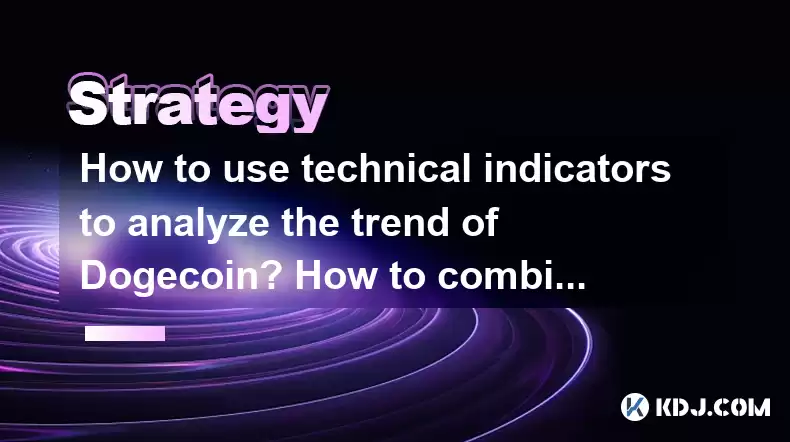-
 bitcoin
bitcoin $108842.957301 USD
-1.88% -
 ethereum
ethereum $3931.777121 USD
-1.66% -
 tether
tether $1.000186 USD
-0.03% -
 bnb
bnb $1153.250882 USD
-2.20% -
 xrp
xrp $2.367904 USD
-1.94% -
 solana
solana $186.182050 USD
-4.20% -
 usd-coin
usd-coin $0.999997 USD
0.00% -
 tron
tron $0.316949 USD
-1.00% -
 dogecoin
dogecoin $0.190780 USD
-3.12% -
 cardano
cardano $0.651324 USD
-2.67% -
 hyperliquid
hyperliquid $37.141055 USD
-0.85% -
 ethena-usde
ethena-usde $0.999224 USD
-0.09% -
 chainlink
chainlink $17.579031 USD
-2.47% -
 bitcoin-cash
bitcoin-cash $509.426284 USD
-2.79% -
 stellar
stellar $0.315298 USD
-2.93%
How to use technical indicators to analyze the trend of Dogecoin? How to combine MACD and RSI?
Use MACD and RSI to analyze Dogecoin's trend: MACD for trend confirmation, RSI for entry/exit points, and watch for divergences for potential reversals.
Apr 28, 2025 at 08:29 pm

Analyzing the trend of Dogecoin using technical indicators is a common practice among cryptocurrency traders. Technical indicators like the Moving Average Convergence Divergence (MACD) and the Relative Strength Index (RSI) are widely used to predict price movements and identify potential trading opportunities. In this article, we will explore how to use these indicators to analyze the trend of Dogecoin and how to combine MACD and RSI for more effective analysis.
Understanding MACD and Its Application to Dogecoin
MACD, or Moving Average Convergence Divergence, is a trend-following momentum indicator that shows the relationship between two moving averages of a cryptocurrency's price. It is composed of two lines: the MACD line and the signal line. The MACD line is calculated by subtracting the 26-period Exponential Moving Average (EMA) from the 12-period EMA. The signal line is a 9-period EMA of the MACD line.
To use MACD for analyzing Dogecoin's trend, follow these steps:
- Open a charting platform that supports Dogecoin, such as TradingView or Binance.
- Add the MACD indicator to the chart. This is usually done by selecting the indicator from a list of available tools.
- Observe the MACD line and the signal line. When the MACD line crosses above the signal line, it is considered a bullish signal, indicating that Dogecoin's price may rise. Conversely, when the MACD line crosses below the signal line, it is a bearish signal, suggesting that the price may fall.
- Look for divergences. If the price of Dogecoin is making new highs but the MACD is not, this could indicate a bearish divergence, suggesting that the upward trend may be losing momentum. Similarly, if the price is making new lows but the MACD is not, this could indicate a bullish divergence, suggesting that the downward trend may be weakening.
Understanding RSI and Its Application to Dogecoin
RSI, or Relative Strength Index, is a momentum oscillator that measures the speed and change of price movements. It ranges from 0 to 100 and is typically used to identify overbought or oversold conditions in a market. An RSI value above 70 is generally considered overbought, while a value below 30 is considered oversold.
To use RSI for analyzing Dogecoin's trend, follow these steps:
- Add the RSI indicator to the Dogecoin chart on your chosen platform.
- Monitor the RSI value. If the RSI rises above 70, it may indicate that Dogecoin is overbought and could be due for a price correction. If the RSI falls below 30, it may indicate that Dogecoin is oversold and could be poised for a price rebound.
- Watch for RSI divergences. Similar to MACD, divergences between the RSI and Dogecoin's price can provide valuable insights. If the price of Dogecoin is making new highs but the RSI is not, this could signal a bearish divergence. If the price is making new lows but the RSI is not, this could signal a bullish divergence.
Combining MACD and RSI for Dogecoin Analysis
Combining MACD and RSI can provide a more comprehensive view of Dogecoin's trend and help traders make more informed decisions. Here's how to combine these indicators effectively:
- Use MACD for trend confirmation. When the MACD line crosses above the signal line, it confirms a bullish trend. When it crosses below, it confirms a bearish trend. Use this information to validate the overall direction of Dogecoin's price movement.
- Use RSI for entry and exit points. When the RSI indicates overbought conditions (above 70), it may be a good time to consider selling or taking profits. When the RSI indicates oversold conditions (below 30), it may be a good time to consider buying or entering a long position.
- Look for confluence. The most powerful signals occur when both MACD and RSI provide the same indication. For example, if the MACD line crosses above the signal line and the RSI is below 30, this could be a strong buy signal. Conversely, if the MACD line crosses below the signal line and the RSI is above 70, this could be a strong sell signal.
- Monitor divergences. If both MACD and RSI show divergences from Dogecoin's price, this can be a strong indication of a potential trend reversal. For instance, if the price is making new highs but both MACD and RSI are not, this could be a strong bearish signal.
Practical Example of Using MACD and RSI on Dogecoin
To illustrate how to use MACD and RSI together, let's consider a hypothetical scenario with Dogecoin:
- Dogecoin's price is currently at $0.30 and has been trending upwards.
- MACD line crosses above the signal line, indicating a bullish trend.
- RSI is at 65, suggesting that Dogecoin is not yet overbought but is approaching that level.
- Action: Based on the MACD signal, you might consider entering a long position. However, since the RSI is nearing overbought territory, you might set a tighter stop-loss to protect against a potential price correction.
In this scenario, the combination of MACD and RSI provides a clear signal to enter a trade while also offering guidance on risk management.
Tips for Using MACD and RSI Effectively with Dogecoin
To maximize the effectiveness of MACD and RSI when analyzing Dogecoin, consider the following tips:
- Use multiple timeframes. Analyzing Dogecoin's trend on different timeframes (e.g., daily, hourly) can provide a more complete picture. A bullish signal on a daily chart might be confirmed by a similar signal on an hourly chart.
- Combine with other indicators. While MACD and RSI are powerful tools, combining them with other indicators like moving averages or Bollinger Bands can provide additional confirmation of trends and potential reversals.
- Stay informed about market news. Technical indicators are most effective when used in conjunction with fundamental analysis. Keep an eye on news and events that could impact Dogecoin's price, such as Elon Musk's tweets or developments in the broader cryptocurrency market.
- Practice risk management. Always use stop-loss orders and manage your position sizes to protect against unexpected market movements. No indicator is foolproof, and it's important to manage risk effectively.
Frequently Asked Questions
Q: Can MACD and RSI be used for short-term trading of Dogecoin?A: Yes, MACD and RSI can be used for short-term trading of Dogecoin. For short-term trades, consider using shorter timeframes (e.g., 15-minute or 1-hour charts) to identify quick entry and exit points. However, be aware that short-term trading carries higher risk due to increased volatility.
Q: How often should I check the MACD and RSI indicators for Dogecoin?A: The frequency of checking MACD and RSI depends on your trading strategy. For long-term investors, checking these indicators daily or weekly may be sufficient. For short-term traders, checking them multiple times a day or even hourly might be necessary to stay on top of rapid price movements.
Q: Are there any limitations to using MACD and RSI for Dogecoin analysis?A: Yes, there are limitations to using MACD and RSI. These indicators can generate false signals, especially in highly volatile markets like cryptocurrency. Additionally, they do not account for external factors such as regulatory news or market sentiment, which can significantly impact Dogecoin's price. It's important to use these indicators as part of a broader analysis strategy.
Q: Can I use MACD and RSI to predict Dogecoin's price?A: While MACD and RSI can provide insights into Dogecoin's trend and potential price movements, they cannot predict the price with certainty. These indicators are tools for analysis and should be used in conjunction with other methods to make informed trading decisions.
Disclaimer:info@kdj.com
The information provided is not trading advice. kdj.com does not assume any responsibility for any investments made based on the information provided in this article. Cryptocurrencies are highly volatile and it is highly recommended that you invest with caution after thorough research!
If you believe that the content used on this website infringes your copyright, please contact us immediately (info@kdj.com) and we will delete it promptly.
- Dogecoin's Wild Ride: Market Turmoil and Price Decline Explained
- 2025-10-17 18:25:12
- Newsmax, Crypto, and the Frontier of Corporate Finance: A New Yorker's Take
- 2025-10-17 18:45:16
- XRP Price, 2030 Prediction, Crypto Presale: Decoding the Future
- 2025-10-17 18:25:12
- Paxos' PYUSD "Oops!" Moment: 300 Trillion Tokens and Crypto's Wild Ride
- 2025-10-17 18:45:16
- Trump, Crypto, and Political Power: A New Coin and a Market Correction
- 2025-10-17 18:50:12
- Bubblemaps, ChainOpera, and COAI Profits: A Deep Dive into the BNB Ecosystem
- 2025-10-17 18:30:13
Related knowledge

Practical parameter settings for a Bitcoin multi-timeframe moving average system
Sep 18,2025 at 10:54pm
Optimizing Timeframe Combinations for Bitcoin Trading1. Selecting appropriate timeframes is crucial when building a multi-timeframe moving average sys...

How can I filter out false breakouts in Dogecoin high-frequency trading?
Sep 22,2025 at 01:00am
Understanding False Breakouts in Dogecoin Trading1. A false breakout occurs when Dogecoin's price appears to move beyond a defined support or resistan...

Techniques for identifying tops and bottoms in the Bitcoin on-chain NVT model
Sep 20,2025 at 07:54pm
Understanding the NVT Model in Bitcoin Analysis1. The Network Value to Transactions (NVT) ratio is often described as the 'P/E ratio' of the cryptocur...

What does the surge in open interest in Bitcoincoin futures mean?
Sep 20,2025 at 11:18pm
Understanding the Surge in Dogecoin Futures Open Interest1. A surge in open interest within Dogecoin futures indicates a growing number of active cont...

How can I use the Ethereum USDT premium to gauge market sentiment?
Sep 18,2025 at 11:55pm
Understanding the Ethereum USDT Premium1. The Ethereum USDT premium refers to the price difference between USDT (Tether) traded on Ethereum-based plat...

What should I do if Ethereum staking yields decline?
Sep 20,2025 at 06:18am
Understanding the Causes Behind Declining Ethereum Staking Yields1. The Ethereum network transitioned to a proof-of-stake consensus mechanism with the...

Practical parameter settings for a Bitcoin multi-timeframe moving average system
Sep 18,2025 at 10:54pm
Optimizing Timeframe Combinations for Bitcoin Trading1. Selecting appropriate timeframes is crucial when building a multi-timeframe moving average sys...

How can I filter out false breakouts in Dogecoin high-frequency trading?
Sep 22,2025 at 01:00am
Understanding False Breakouts in Dogecoin Trading1. A false breakout occurs when Dogecoin's price appears to move beyond a defined support or resistan...

Techniques for identifying tops and bottoms in the Bitcoin on-chain NVT model
Sep 20,2025 at 07:54pm
Understanding the NVT Model in Bitcoin Analysis1. The Network Value to Transactions (NVT) ratio is often described as the 'P/E ratio' of the cryptocur...

What does the surge in open interest in Bitcoincoin futures mean?
Sep 20,2025 at 11:18pm
Understanding the Surge in Dogecoin Futures Open Interest1. A surge in open interest within Dogecoin futures indicates a growing number of active cont...

How can I use the Ethereum USDT premium to gauge market sentiment?
Sep 18,2025 at 11:55pm
Understanding the Ethereum USDT Premium1. The Ethereum USDT premium refers to the price difference between USDT (Tether) traded on Ethereum-based plat...

What should I do if Ethereum staking yields decline?
Sep 20,2025 at 06:18am
Understanding the Causes Behind Declining Ethereum Staking Yields1. The Ethereum network transitioned to a proof-of-stake consensus mechanism with the...
See all articles










































































